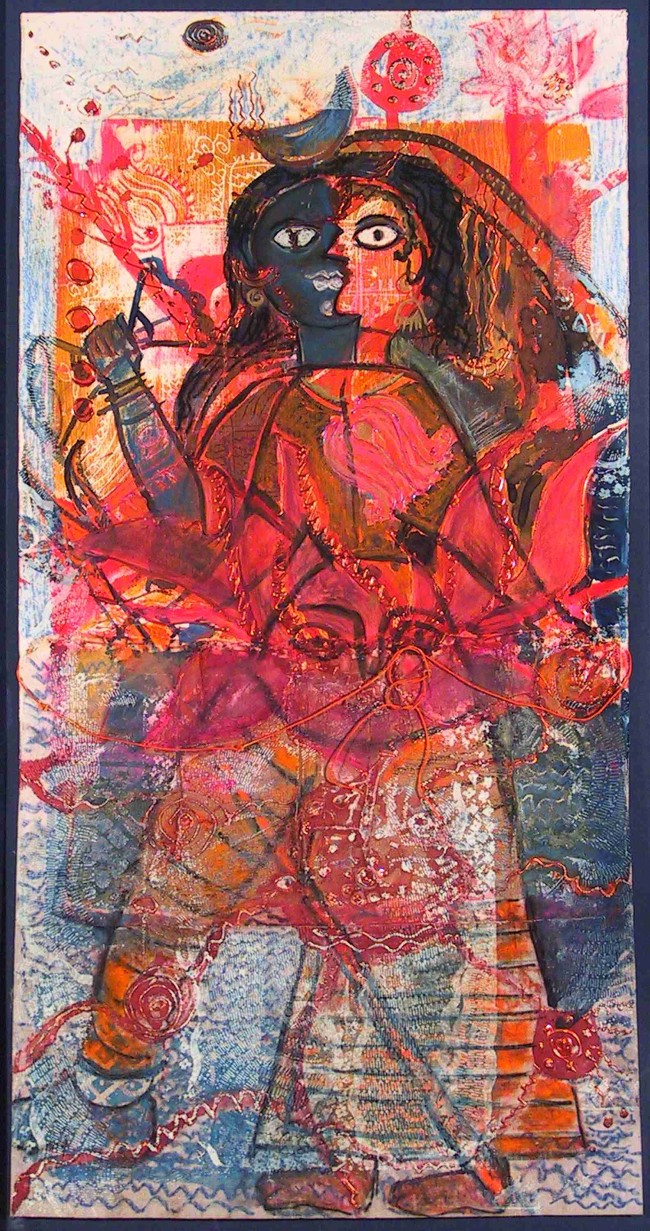YWCA Women’s Art Gallery June 20 – Sept 11, 2014
A variety of work made by women artists born abroad are featured in this exhibit, expressing their diverse styles in a variety of mediums and formats. Selected from eight different national backgrounds, these artists live in the Cincinnati area. Their roots run deep in their respective homelands, however, and their art enriches our community. This review will select several works for discussion.
Indian born Radha Lakshmi’s mixed media designs explore the theme of woman/world with a high degree of design and symbolism. Her large work, “Sacred Thread II” involves a substructure of stenciling, texturing and embossing. Depicted in symbolic elements, the woman stands on the earth in bare feet, her right hand holding a stylus or paint brush. Added elements of twine and cloth embellish this probable selfie, a commanding woman crowned by the moon, in crimson, orange and copper.
Flanking this work are Korean artist Bukang Kim’s twin acrylic paintings. Entitled “Ocean I and II”, these works are painterly expressions of roiling seas in royal blues and turquoises. Amid the white caps and submerged phantoms, a series of calligraphic gestures with enough linearity to resemble illegible lines of loose script, seem to be moments away from reverting to sea-lost thoughts, an excellent example of what the painterly gesture means in abstract expressionist painting.
Eunshin Khang, also Korean, paints “When Spring Comes”. This dreamy landscape shows undulating multicolor hills dotted with moon ponds and caressed by a softly rising sun. Gestural underdrawing throughout adds a layer of mystery in the mist. She shows another acrylic” Dreamscape Summer” which utilizes similar elements but in an unconventional (for landscape) square format. Added scumblings of textured paint accent the heated color palette of red, yellow, and orange with complements of blue and purple.
The mosaic format is unique in this exhibit to American Ximena Flores. Her whimsical pieces incorporate shards of broken pottery into new designs that create fanciful and charming imaginings. A large yellow sun ensconced in a royal blue heaven, illuminates a strip field of broken strawberry patch painted shards. An inverted broken turquoise teapot lid is credible as a small fountain which is visited by an exotic bird exquisitely painted on a small shard of fine china.
In another work, the square tile format is divided into day and moon dominated night. A small ship, emerging from the plane, sails from night into day, its anchoring mechanisms challenging the limitations of the format.
Setsuko LeCroix, a Japanese born artist, displays work that bridges Eastern and Western cultural platforms. Setsuko presents an image of Bishamonten, who is revered in Japan as the Buddhist deity of warfare. He has a fiery countenance and is formidably clad in armor. His head is wreathed with holy flames and he holds a trident spear in one hand, and in the other a small pagoda symbolizing the divine treasure house, whose contents he both guards and gives away. LeCroix animates the warrior’s half figure with low light placement accentuating the deity’s focus on the pagoda treasure house he is holding out to the viewer on the right, thus emphasizing his generosity. Executed in earth tones of golden browns, the painting uses Western oil painting techniques to bring the Japanese version of this Buddhist deity to life.
LeCroix presents two additional paintings that manifest her interest in understanding the definition of traditional ‘beauty’ in subject matter as well as technique in western oil painting. Her painting “Queen of the Night” is a sensitively rendered flowering of the Night Blooming Ceres, a mysterious and exotically fragranced bloom. “Memory in Red” is a portrait bust of an American woman. Here she hones her skills in portraying concepts of Western beauty while refining the oil portrait technique.
The journey of transformation is also evident in the works of Korean born Young Hi Lee. Lee presents several works executed in sumi ink on mulberry paper, a great traditional medium in her country. For her moving triptych entitled “Old Vine Trunks I, II, III”, the mulberry paper is stretched on same sized frames and presents a horizontal compositional continuum. Expressively painted leafless trees writhe in a descending field, having long ago dropped their leaves. A bright moon hangs in the windswept sky in the third panel. Ink runs in red and black perversely defying gravity by seeming to flow upward.
The fluid composition and her mastery of the brush combine to treat the characteristics of a natural season with emotionalised connotations, interpreting with empathy the cross-like tortured stances of the trees. Her statement is a contemporary answer in tune with her national idiom of speaking in natural symbolism.
In another work, “Reflections”, Tea and ink stains float across the ragged edged manuscript whose message is encrypted in vertically read character symbols. Overpasted on the left is a sumi ink drawing of a woman in western garb, her assertive stance accented with hand on hip. She surveys the expanse of text and several floating blocks of paint spangled origami. We see Hi Lee as she sees herself, expressing her perceptions with new building blocks, as the work becomes a visual statement of self transformation.
By: Marlene Steele








